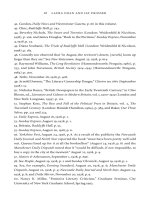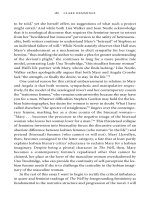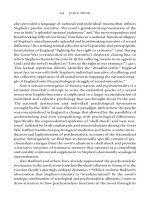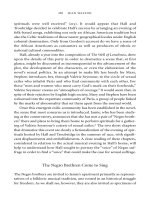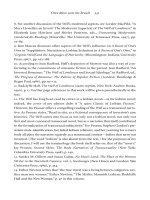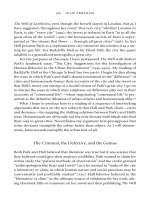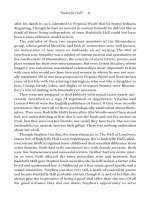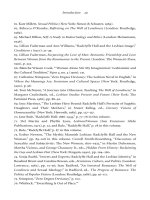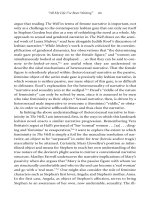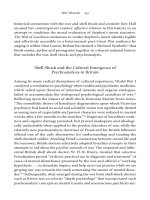Palatable poison 348
Bạn đang xem bản rút gọn của tài liệu. Xem và tải ngay bản đầy đủ của tài liệu tại đây (38.05 KB, 1 trang )
Once More unto the Breach
333
8. For another discussion of the Well’s modernist aspects, see Loralee MacPike, “Is
Mary Llewellyn an Invert? The Modernist Supertext of The Well of Loneliness,” in
Elizabeth Jane Harrison and Shirley Peterson, eds., Unmanning Modernism:
Gendered Re-Readings (Knoxville: The University of Tennessee Press, 1997), pp.
73–89.
9. Jane Marcus discusses other aspects of the Well’s influence on A Room of One’s
Own in “Sapphistory: Narration as Lesbian Seduction in A Room of One’s Own,” in
Virginia Woolf and the Languages of Patriarchy (Bloomington: Indiana University
Press, 1987), pp. 163–188.
10. According to Jean Radford, Hall’s depiction of Morton was also a way of conforming to the conventions of romantic fiction in the period. Jean Radford, “An
Inverted Romance: “The Well of Loneliness and Sexual Ideology,” in Radford, ed.,
The Progress of Romance: The Politics of Popular Fiction (London: Routledge &
Kegan Paul, 1986), pp. 97–112.
11. Radclyffe Hall, The Well of Loneliness (1928; reprint, New York: Anchor Books,
1990), p. 11. Further page references to this work will be given parenthetically in the
text.
12. The Well has long been read by critics as a lesbian novel—as the lesbian novel;
indeed, the cover of my edition dubs it “A 1920s Classic of Lesbian Fiction.”
However, Jay Prosser offers a compelling reading of the Well as a transsexual narrative. As Prosser states, “Read in situ, as a fictional consequence of inversion’s case
histories, The Well comes into focus as not only not a lesbian novel, not only our
first and most canonical transsexual novel, but as a narrative that itself contributed
to the formalization of transsexual subjectivity.” For Prosser, Stephen Gordon’s persistent male-identification, her failed lesbian relations, and her yearning for a man’s
body all place the narrative squarely in a transsexual context—before that term was
invented. (The word “lesbian” is also absent from the text.) For the purposes of my
discussion, I will use the terminology the book itself relies on, that of the “invert.”
Jay Prosser, Second Skins: The Body Narratives of Transsexuality (New York:
Columbia University Press, 1998), p. 140.
13. Sandra M. Gilbert and Susan Gubar, No Man’s Land: The Place of the Woman
Writer in the Twentieth Century, vol. 2, Sexchanges (New Haven and London: Yale
University Press, 1989), p. 354.
14. Esther Newton writes that “the true invert was a being between categories, neither man nor woman.” Esther Newton, “The Mythic Mannish Lesbian: Radclyffe
Hall and the New Woman,” p. 97 in this volume.
